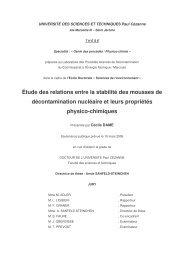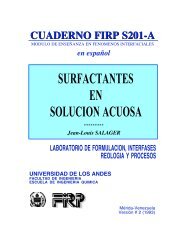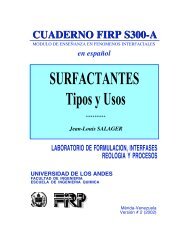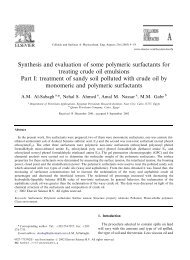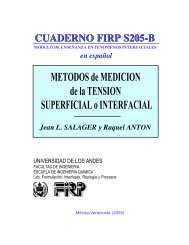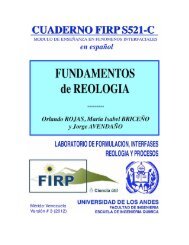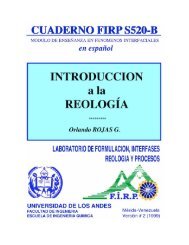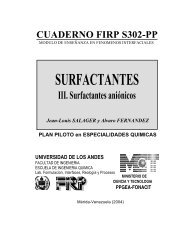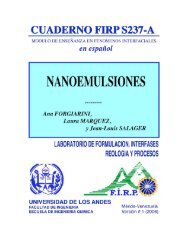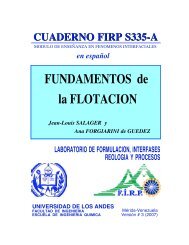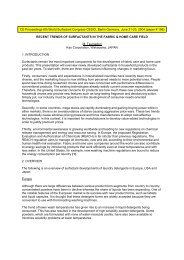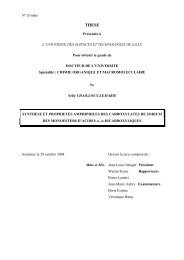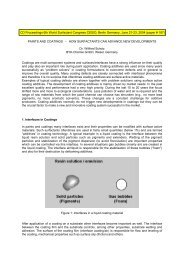Solubilization-emulsification mechanisms of detergency
Solubilization-emulsification mechanisms of detergency
Solubilization-emulsification mechanisms of detergency
You also want an ePaper? Increase the reach of your titles
YUMPU automatically turns print PDFs into web optimized ePapers that Google loves.
C.A. Miller and K.H. Raney/Colloids Surfaces A: Physicochem. Eng. Aspects 74 (1993) 169-215 209<br />
mixed soils. Maximum <strong>detergency</strong> is reached<br />
near 40ºC with 10% oleyl alcohol in the soil<br />
while high levels <strong>of</strong> cetane removal are attained<br />
down to 20ºC with 25% oleyl alcohol present.<br />
The temperatures at the lower limit <strong>of</strong> the<br />
plateaus in <strong>detergency</strong> are the respective phase<br />
inversion temperatures. For C 12E 7, PIT values<br />
can be obtained from the curves in Fig. 15.<br />
Above the PIT, soil removal remains at a high<br />
level until the cloud point <strong>of</strong> the surfactant is<br />
reached. As implied in the oil drop-contacting<br />
section, the formation <strong>of</strong> an intermediate liquid<br />
crystalline phase plays the key role in the<br />
soilremoval process in the plateau regime.<br />
The relative amount <strong>of</strong> polar soil also affects<br />
the rate <strong>of</strong> soil removal. Despite being removed<br />
at a comparable level to that <strong>of</strong> the 3/1<br />
cetane-oleyl alcohol soil after 10 min at 50ºC,<br />
the 9/1 soil is actually removed much more<br />
quickly, as indicated in Fig. 50. This very fast<br />
removal can be attributed to that soil having a<br />
PIT <strong>of</strong> approximately 50ºC with C 12E 7. A 1/1<br />
cetane-oleyl alcohol soil is removed very slowly<br />
at 50ºC, although a high level <strong>of</strong> removal is<br />
ultimately attained. Removal <strong>of</strong> the hexadecane<br />
soil reaches a plateau at a lower level since the<br />
washing temperature is well below the optimum<br />
<strong>detergency</strong> temperature for its removal by C 12E 7,<br />
i.e. approximately 80ºC.<br />
Fig. 50. Kinetics <strong>of</strong> n-hexadecane removal for mixed<br />
n-hexadecane-oleyl alcohol blends [12]. Reprinted<br />
with permission <strong>of</strong> the American Oil Chemists'<br />
Society.<br />
Similar results to those described for<br />
hexadecane-oleyl alcohol soils were obtained<br />
for hexadecane-oleic acid soils having the same<br />
ratio <strong>of</strong> nonpolar and polar constituents. These<br />
studies were performed in the absence <strong>of</strong><br />
triethanolarnine to insure that the oleic acid was<br />
in the non-ionized state. Also, the oleic acid was<br />
tagged with 14C-labeled material to allow<br />
measurement <strong>of</strong> its removal as well as that <strong>of</strong><br />
hexadecane. The results for 3/1 cetane-oleic acid<br />
soil are shown in Fig. 51. High levels <strong>of</strong> soil<br />
removal were found over a wide temperature<br />
range from 20ºC to the cloud point <strong>of</strong> the<br />
surfactant. As with the oleyl alcoholcontaining<br />
soils, optimum removal was found between the<br />
PIT and cloud point temperature. Interestingly,<br />
the data show that the removal <strong>of</strong> oleic acid<br />
paralleled that <strong>of</strong> cetane, although at levels<br />
10-20% higher. This behavior results from the<br />
higher ratio <strong>of</strong> oleic acid to hexadecane found in<br />
the intermediate liquid crystalline phase<br />
compared to that in the original soil.<br />
Presumably, preferential removal <strong>of</strong> oleyl<br />
alcohol would have been found in the<br />
hexadecane-oleyl alcohol experiments if the<br />
alcohol had been radioactively tagged.<br />
11. Discussion<br />
As shown above, maximum removal <strong>of</strong> liquid<br />
hydrocarbon soil from synthetic fabrics in non-<br />
Fig. 51. Oil removal for mixed 3/1 n-hexadecaneoleic<br />
acid soil [12]. Reprinted with permission <strong>of</strong> the<br />
American Oil Chemists' Society.



